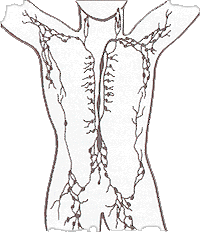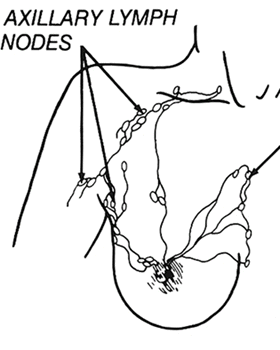This section is intended to serve as an introduction to lymph nodes and the lymphatic system. Because breast cancer often spreads first to the axillary (underarm) lymph nodes from the breast, determining whether the lymph nodes contain cancer is an essential part of the breast cancer diagnostic process. The status of the lymph nodes helps physicians stage breast cancer, and in turn, determine treatment.
The lymphatic system is an essential part of the immune system, which helps the body fight infections or cancers. The lymphatic system consists of a network of vessels that drain tissue fluid (lymph) into lymph nodes, larger fluid-containing lymph ducts, and specialized organs involved in the immune system. The lymph nodes and organs act as a type of “filter,†removing invading organisms or abnormal cells from the lymph fluid and “processing†them in a way that allows the body to fight these harmful agents. Lymph is a clear whitish/yellowish fluid that contains white blood cells (lymphocytes), proteins, and some red blood cells.

The lymphatic system. Courtesy of NIH/NCI
The bean-shaped lymph nodes of the lymphatic system are connected by vessels. Lymph nodes are usually present in clusters in the armpits, on either side of the neck, and in the groin. The lymph nodes filter lymph fluid and trap foreign materials. Any fluid absorbed by the lymphatic system passes through at least one lymph node before it returns to circulation.
The lymph nodes contain lymphocytes (white blood cells) which help destroy foreign bacteria or other harmful cells. The lymph nodes may become enlarged or swollen when they fight an infection since they must produce additional white blood cells. The lymph nodes may feel tender or inflamed as they are actively fighting a foreign body. Sometimes, the lymphatic vessels will become visible as thin red lines along a limb as the result of an infection (known as lymphangitis). Lymph nodes may also swell from the formation of an abscess (closed pocket filled with pus) in the nodes or if they contain cancer cells.
Whether the lymph nodes contain cancer cells is an important factor when staging breast cancer, determining treatment, and predicting survival. Though breast cancer has the potential to spread to other regions of the body first, it most commonly spreads first to the axillary (underarm) lymph nodes. This is known as regional spread. From there, the breast cancer can metastasize (spread) systematically to other areas of the body (such as the bone, liver, lung, or brain).

Courtesy NIH/NCI
If a woman is diagnosed with invasive breast cancer (cancer that has invaded past the wall of the breast duct or lobule and into surrounding breast tissue), it is necessary to examine the axillary lymph nodes to determine whether they contain cancer.
Non-Invasive Breast Cancer
Cancer cells that are confined to the ducts and do not invade surrounding fatty and connective tissues of the breast. Ductal carcinoma in situ (DCIS) is the most common form of non-invasive breast cancer (90%). Lobular carcinoma in situ (LCIS) is less common and considered a marker for increased breast cancer risk.
Invasive Breast Cancer
Cancer cells that break through the duct and lobular wall and invade the surrounding fatty and connective tissues of the breast. Cancer can be invasive without being metastatic (spreading) to the lymph nodes or other organs.
Determining whether the lymph nodes are free of cancer or not is an essential part of the breast cancer staging process and will help determine treatment and prognosis. Tumor size and the extent to which breast cancer has metastasized (spread) to other regions of the body is also examined.
| Staging Breast Cancer | |||
| Stage | Tumor Size | Lymph Node Involvement | Metastasis (Spread) |
| I | Less than 2 cm | No | No |
| II | Between 2-5 cm | No, or in same side of breast | No |
| III | More than 5 cm | Yes, on same side of breast | No |
| IV | Not applicable | Not applicable | Yes |
The standard way to examine the lymph nodes is to perform an axillary node dissection. This procedure is often done during the same operation as a lumpectomy or mastectomy and involves removing 10 to 30 lymph nodes for pathological examination under a microscope. The most common side effect of an axillary node dissection is lymphedema (chronic swelling) of the arm, which may affect up to 10% of patients. Lymphedema occurs when the normal process of draining lymph from the arm is disrupted or blocked, causing fluid to build up in the arm.
Another surgical option called a sentinel node biopsy is now being used on select breast cancer patients to determine whether breast cancer is present in the lymph nodes. A sentinel node biopsy involves removing only one to three sentinel lymph nodes (the first nodes in the lymphatic chain).
Studies continue to show that removing fewer lymph nodes may decrease the chance of developing lymphedema, though research on sentinel node biopsy is ongoing. The degree to which sentinel node biopsy is effective in determining whether the lymph nodes contain cancer has been shown in research to be directly related to the experience of the surgeon who is performing the procedure. If the sentinel node(s) is found to be cancerous upon removal, a complete axillary node dissection is usually performed.



